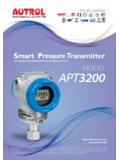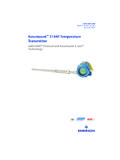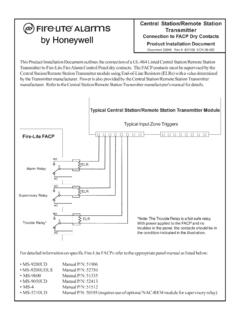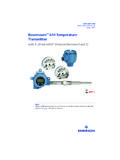Transcription of Universal Asynchronous Receiver/Transmitter …
1 KeyStone Architecture Literature Number: SPRUGP1 November 2010 Universal Asynchronous Receiver/Transmitter (UART)User Guide -iiKeyStone Architecture Universal Asynchronous Receiver/Transmitter (UART) User GuideSPRUGP1 November Documentation Feedback Release HistoryReleaseDateChapter/ 2010 AllInitial ReleaseContentsSPRUGP1 November 2010 KeyStone Architecture Universal Asynchronous Receiver/Transmitter (UART) User Guide -iiiSubmit Documentation Feedback History.. -iiList of Tables .. -vList of Figures .. -viPreface -viiAbout This Manual .. -viiNotational Conventions .. -viiRelated Documentation from Texas Instruments.
2 -viiiTrademarks .. -viiiChapter Purpose of the Peripheral .. Features .. Functional Block Diagram .. Industry Standard(s) Compliance Statement .. 1-4 Chapter Clock Generation and Control .. Signal Descriptions .. Pin Multiplexing .. Protocol Description .. Transmission.. Reception.. Data Format .. Operation .. Transmission.. Reception.. FIFO Modes .. FIFO Interrupt Mode .. FIFO Poll Mode .. Autoflow Control .. UARTn_RTS Behavior .. UARTn_CTS Behavior .. Loopback Control .. Reset Considerations.. Software Reset Considerations .. Hardware Reset Considerations.
3 Initialization .. Interrupt Support .. Interrupt Events and Requests .. Interrupt Multiplexing.. DMA Event Support .. Power Management .. Emulation Considerations .. Exception Processing .. Divisor Latch Not Programmed .. Changing Operating Mode During Busy Serial Communication ..2-14 Contents -ivKeyStone Architecture Universal Asynchronous Receiver/Transmitter (UART) User GuideSPRUGP1 November 2010 Submit Documentation Feedback receiver Buffer Register (RBR) .. transmitter Holding Register (THR) .. Interrupt Enable Register (IER) .. Interrupt Identification Register (IIR) .. FIFO Control Register (FCR).
4 Line Control Register (LCR) .. Modem Control Register (MCR) .. Line Status Register (LSR).. Modem Status Register (MSR) .. Scratch Pad Register (SCR) .. Divisor Latches (DLL and DLH) .. Revision Identification Registers (REVID1 and REVID2).. Power and Emulation Management Register (PWREMU_MGMT).. Mode Definition Register (MDR) .. 3-22 IndexIX-1 List of TablesSPRUGP1 November 2010 KeyStone Architecture Universal Asynchronous Receiver/Transmitter (UART) User Guide -vSubmit Documentation Feedback of TablesTable 2-1 Baud Rate Examples for 150-MHz UART Input Clock and 16 Oversampling Mode .. 2-3 Table 2-2 Baud Rate Examples for 150-MHz UART Input Clock and 13 Oversampling Mode.
5 2-3 Table 2-3 UART Signal Descriptions .. 2-4 Table 2-4 Character Time for Word Lengths .. 2-8 Table 2-5 UART Interrupt Requests Descriptions.. 2-12 Table 3-1 UART Registers .. 3-2 Table 3-2 receiver Buffer Register (RBR) Field Descriptions .. 3-3 Table 3-3 transmitter Holding Register (THR) Field Descriptions .. 3-4 Table 3-4 Interrupt Enable Register (IER) Field Descriptions .. 3-5 Table 3-5 Interrupt Identification Register (IIR) Field Descriptions .. 3-6 Table 3-6 Interrupt Identification and Interrupt Clearing Information .. 3-7 Table 3-7 FIFO Control Register (FCR) Field Descriptions .. 3-8 Table 3-8 Line Control Register (LCR) Field Descriptions.
6 3-10 Table 3-9 Relationship Between ST, EPS, and PEN Bits in LCR .. 3-11 Table 3-10 Number of STOP Bits Generated .. 3-11 Table 3-11 Modem Control Register (MCR) Field Descriptions .. 3-12 Table 3-12 Line Status Register (LSR) Field Descriptions .. 3-13 Table 3-13 Modem Status Register (MSR) Field Descriptions .. 3-16 Table 3-14 Scratch Pad Register (MSR) Field Descriptions .. 3-17 Table 3-15 Divisor LSB Latch (DLL) Field Descriptions .. 3-18 Table 3-16 Divisor MSB Latch (DLH) Field Descriptions .. 3-19 Table 3-17 Revision Identification Register 1 (REVID1) Field Descriptions .. 3-20 Table 3-18 Revision Identification Register 2 (REVID2) Field Descriptions.
7 3-20 Table 3-19 Power and Emulation Management Register (PWREMU_MGMT) Field Descriptions .. 3-21 Table 3-20 Mode Definition Register (MDR) Field Descriptions .. 3-22 List of Figures -viKeyStone Architecture Universal Asynchronous Receiver/Transmitter (UART) User GuideSPRUGP1 November 2010 Submit Documentation Feedback of FiguresFigure 1-1 KeyStone Device Universal Asynchronous Receiver/Transmitter (UART) Block Diagram .. 1-3 Figure 2-1 UART Clock Generation Diagram .. 2-2 Figure 2-2 Relationships Between Data Bit, BCLK, and UART Input Clock .. 2-3 Figure 2-3 UART Protocol Formats .. 2-5 Figure 2-4 UART Interface Using Autoflow Diagram.
8 2-9 Figure 2-5 Autoflow Functional Timing Waveforms for UARTn_RTS .. 2-9 Figure 2-6 Autoflow Functional Timing Waveforms for UARTn_CTS.. 2-10 Figure 2-7 UART Interrupt Request Enable Paths .. 2-13 Figure 3-1 receiver Buffer Register (RBR) .. 3-3 Figure 3-2 transmitter Holding Register (THR) .. 3-4 Figure 3-3 Interrupt Enable Register (IER) .. 3-5 Figure 3-4 Interrupt Identification Register (IIR) .. 3-6 Figure 3-5 FIFO Control Register (FCR) .. 3-8 Figure 3-6 Line Control Register (LCR).. 3-10 Figure 3-7 Modem Control Register (MCR) .. 3-12 Figure 3-8 Line Status Register (LSR) .. 3-13 Figure 3-9 Modem Status Register (MSR).
9 3-16 Figure 3-10 Scratch Pad Register (SCR) .. 3-17 Figure 3-11 Divisor LSB Latch (DLL) .. 3-18 Figure 3-12 Divisor MSB Latch (DLH) .. 3-19 Figure 3-13 Revision Identification Register 1 (REVID1).. 3-20 Figure 3-14 Revision Identification Register 2 (REVID2).. 3-20 Figure 3-15 Power and Emulation Management Register (PWREMU_MGMT) .. 3-21 Figure 3-16 Mode Definition Register (MDR).. 3-22 SPRUGP1 November 2010 KeyStone Architecture Universal Asynchronous Receiver/Transmitter (UART) User Guide -viiSubmit Documentation Feedback PrefaceAbout This ManualThe Universal Asynchronous Receiver/Transmitter (UART) performs serial-to-parallel conversions on data received from a peripheral device and parallel-to-serial conversion on data received from the CPU.
10 The UART includes control capability and a processor interrupt system that can be tailored to minimize software management of the communications ConventionsThis document uses the following conventions: Commands and keywords are in boldface font. Arguments for which you supply values are in italic font. Terminal sessions and information the system displays are in screenfont. Information you must enter is in boldface screen font. Elements in square brackets ([ ]) are use the following conventions:Note Means reader take note. Notes contain helpful suggestions or references to material not covered in the information in a caution or a warning is provided for your protection.













